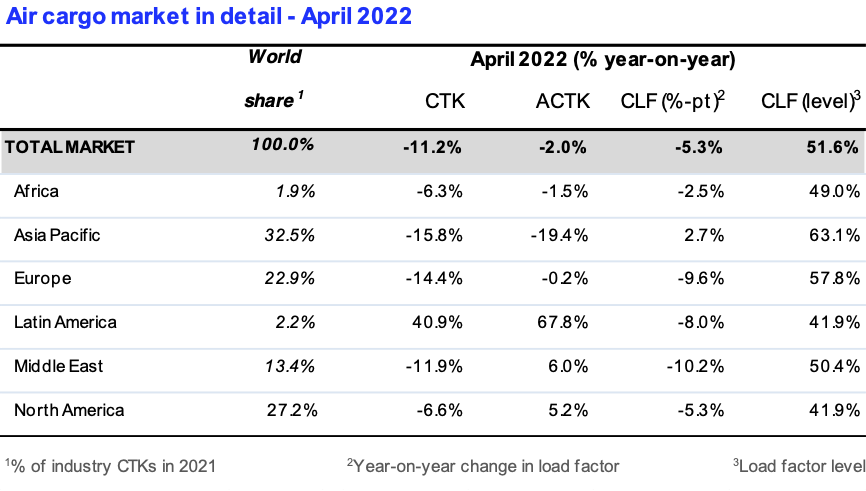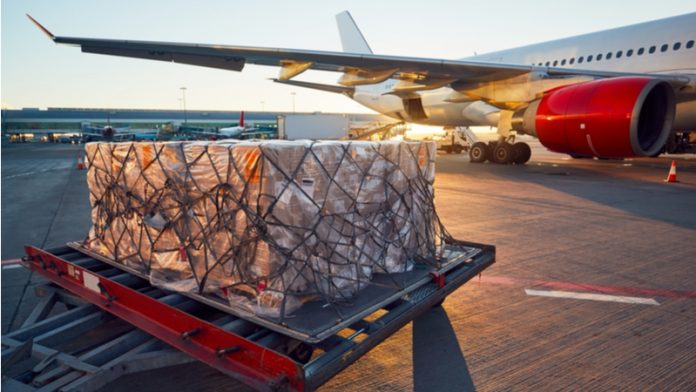The International Air Transport Association (IATA) released data until April 2022 for global air cargo markets that showed a drop in demand and contraction in capacity.
The effects of OMICRON in Asia and the Russia–Ukraine war, as per IATA, continue to create a challenging operating backdrop that is driving the decline.
Key Pointers:
– Global demand, measured in cargo tonne-kilometres (CTKs*), fell 11.2 per cent compared to April 2021 (-10.6 per cent for international operations). Global demand is down 1 per cent compared to April 2019.
– Capacity was 2 per cent below 2021 (+1.2 per cent for international operations). Both global capacity and international capacity decreased slightly in April compared to March. Asia experienced the largest falls in capacity.
– Factors in the operating environment should be noted:
- The war in Ukraine led to a fall in cargo capacity used to serve Europe as several airlines based in Russia and Ukraine were key cargo players. And the zero-COVID policy in China led to capacity challenges due to flight cancellations because of labour shortages.
– New export orders, a leading indicator of cargo demand and world trade are now shrinking in all markets except the US. Global goods trade has continued to decline in 2022, with China’s economy growing more slowly because of COVID-19 related lockdowns (among other factors).
The lockdowns have brought much of the world’s largest port, Shanghai, to a standstill. Supply chain disruptions due to the Ukraine-Russia conflict are also adding to the downward pressure on trade.
“Air cargo demand fell by 11.2 per cent in April and capacity contracted 2 per cent compared to April 2021. The combination of the war in Ukraine and COVID-19 lockdowns in China have pushed up energy costs, intensified supply chain disruptions, and fed inflation.
“The operating environment is challenging for all businesses, including air cargo. But with China easing lockdown restrictions, there is cause for some optimism and the supply/demand imbalance is keeping yields high,” said Willie Walsh, IATA’s Director-General.

April Regional Performance
Asia-Pacific airlines saw their air cargo volumes decrease by 15.8 per cent in April 2022 compared to the same month in 2021. This was the weakest performance of all regions and significantly slower than the previous month (-5.1 per cent). Airlines in the region have been heavily impacted by lower trade and manufacturing activity due to Omicron-related lockdowns in China. Because of this, available capacity in the region fell 19.4 per cent compared to April 2021, the largest drop of all regions.
North American carriers posted a 6.6 per cent decrease in cargo volumes in April 2022 compared to April 2021. Demand in the Asia-North America market declined significantly, however, other key routes such as Europe – North America remain strong. Capacity was up 5.2 per cent compared to April 2021. Several carriers in the region are set to receive delivery of freighters in 2022, which should help address pent-up demand on routes where it is needed.
European carriers saw a 14.4 per cent decrease in cargo volumes in April 2022 compared to the same month in 2021. The Within Europe market fell significantly, down 24.6 per cent month on month. This is attributable to the war in Ukraine. Labour shortages and lower manufacturing activity in Asia due to Omicron also affected volumes. Capacity fell 0.2 per cent in April 2022 compared to April 2021.
Middle Eastern carriers experienced a 11.9 per cent year-on-year decrease in cargo volumes in April. Significant benefits from traffic being redirected to avoid flying over Russia failed to materialize. This is likely due to persisting supply chain issues in Asia. Capacity was up 6 per cent compared to April 2021.
Latin American carriers reported an increase of 40.9 per cent in cargo volumes in April 2022 compared to the 2021 period. This was the strongest performance of all regions. Airlines in this region have shown optimism by introducing new services and capacity, and in some cases investing in additional aircraft for air cargo in the coming months. Capacity in April was up 67.8 per cent compared to the same month in 2021.
African airlines saw cargo volumes decrease by 6.3 per cent in April 2022 compared to April 2021. This was significantly slower than the growth recorded the previous month (3.1 per cent). Capacity was 1.5 per cent below April 2021 levels.
Note from IATA: We returned to year-on-year traffic comparisons, instead of comparisons with the 2019 period, unless otherwise noted.






